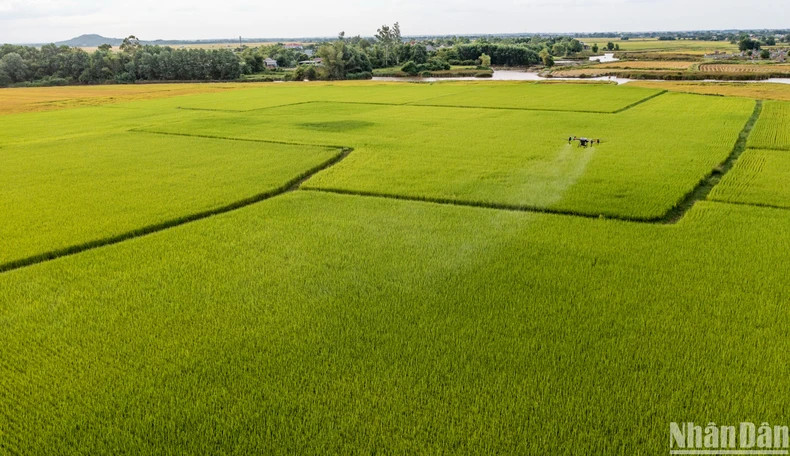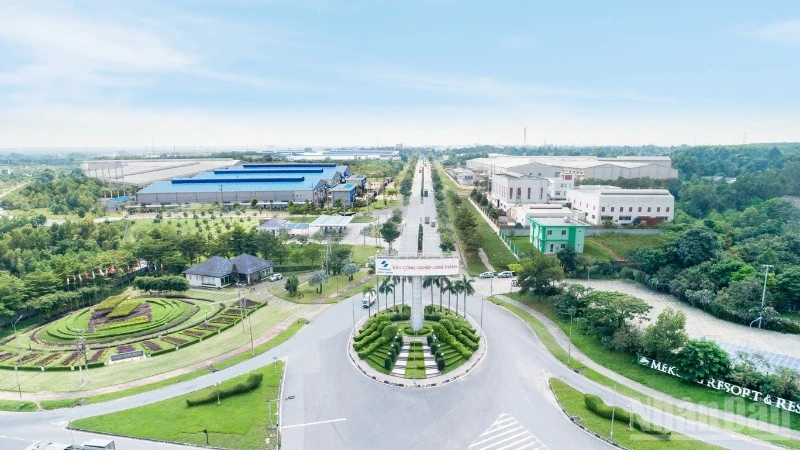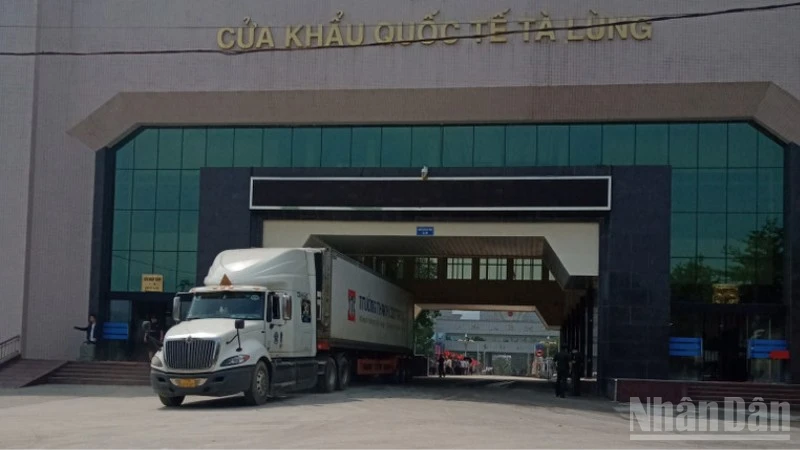Changing lives thanks to organic rice
Following the order of the People’s Committee of Quang Tri Province to contribute to protecting the health of consumers and the environment, since 2021, Quang Tri Trading Corporation (Sepon Group) has implemented a project to link production and consume organic rice products on a large scale in 5 districts: Hai Lang, Trieu Phong, Cam Lo, Gio Linh, and Vinh Linh. The growing area in Tien My currently has the largest cultivation area among the 5 growing areas under Sepon's organic rice production and consumption project.
The unit has hired experts to survey and analyse soil quality in the fields of several districts as well as other districts to find suitable land areas. Producing organic rice that meets export standards for demanding markets requires effort and professionalism from the stages of land preparation, planting, care, harvesting, processing and preservation with strict requirements to fully meet organic criteria.
 |
| Organic rice fields in Tien My Village, Vinh Lam Commune, Vinh Linh District, Quang Tri Province. |
The entire area is far from sources of pollution, tested for 405 indicators of plant protection chemicals and 6 indicators of heavy metals meeting requirements. The water in this area is clean, having been tested for 35 indicators of surface water quality. The S25 variety, which has twice won the title of the world's best rice, was researched and developed by engineer Ho Quang Cua and selected by Sepon as a variety for organic growing areas.
These growing areas are carefully inspected, ensuring that no pesticides are used for 3 years. 100% of the people must be trained by specialised agencies and technical staff must have a notebook to record rice care diary until harvest.
As with the people in Tien My Village, Vinh Lam Commune, in the past three years, Nguyen Thi Nguyet has found that farming and sticking to the fields has never been so leisurely. Nguyet shared that in the past, she and her husband had to go to the fields every day to take care of the rice, weed, and spray pesticides. All day long, they worked hard to protect the soil and their backs to the sky, but the grass still grew wildly. The worst thing was that every time they sprayed pesticides, they were absorbed into their bodies. They knew they would get sick, but if they didn't spray, the worms would eat all the rice.
 |
| Nguyet’s family has changed their lives thanks to growing organic rice. |
Meanwhile, Nguyen Hai Tien, Director of Tien My Agricultural Service Cooperative, Vinh Lam Commune, Vinh Linh District, said that Tien My Agricultural Service Cooperative is also one of the units participating in the production of ST25 organic rice. When growing this rice, people are provided with a full package of production input services including organic fertilisers, tray seedlings, transplanting services, biological products and drones spraying products and technical consulting services for the fields.
At the end of the season, the company buys fresh rice at 13,000 VND/kg. Standing next to the rice field that has just been harvested in the summer-autumn crop, Ho Van Chung of Tien My Cooperative excitedly said: “This year, I have been able to plant 1.5 hectares of rice. My field says no to chemical fertilisers, only uses microbial fertilisers, protects the environment, and brings clean rice to consumers. Since growing Sepon organic rice, we have had less trouble and have had higher income.”
Applying technology to rice cultivation
The difference in science and technology in organic rice cultivation process can be seen in the use of transplanters and seeders, drones to spray pesticides, and modern, high-tech drying, milling, and preservation systems.
The combination of businesses and people in organic rice cultivation has helped to increase mechanisation in production, thus increasing economic efficiency for local people. Accordingly, businesses provide technical support, provide seeds, input materials, and consume products; farmers produce on their own land. As a result, farmers will not lose land, but their land in new-style agricultural cooperatives will be cleared of fragmented fields, forming large fields, neatly divided into plots according to the canal system according to technical standards and convenient traffic infrastructure for planting and care to ensure compliance with requirements.
 |
| Organic rice in Vinh Linh District, Quang Tri Province. |
The project to develop organic rice, VietGAP phase 2021-2025 was assigned by the People’s Committee of Quang Tri Province, with Sepon Group as the investor, to form and develop specialised rice production areas through cooperation with agricultural production service cooperatives, contributing to improving income and quality of life of rice farmers. The project aims to build a linkage model between 5 parties: the state, businesses, scientists, farmers, and banks.
According to Phung Anh Chinh, a technical officer of Sepon Company, growing rice using Sepon's technology is very convenient for farmers. The company provides delicious rice varieties ST25, supports farmers from sowing and transplanting to harvesting, and guarantees product consumption.
 |
| Technicians prepare a mixture of eggs and milk to spray on rice. |
After transplanting, farmers and technical staff only check to see if the transplanting ratio is met. If the transplanting is still sparse, farmers and technical staff go back and replant. During the entire time from when the rice is transplanted until harvest, technical staff will closely monitor each stage. In the 11 organic rice growing processes, people only perform 5 steps, while the rest are performed by technical staff.
In many very special stages to make organic rice grains, a particularly impressive technique that many localities are learning is spraying egg milk on rice.
According to Ho Xuan Hieu, Chairman of the Board of Directors of Quang Tri Trading Corporation (Sepon Group), the mixture made from chicken eggs and fresh milk is considered a nutritious product, especially amino acids, providing nutrients for rice plants. Rice directly absorbs amino acids into the plant, providing a part of protein for the plant, helping the grains to be firm.
In addition, the remaining substances from the mixture of eggs and milk stuck on the leaves become food for exogenous fungi to grow. When this type of fungus grows, it will secrete substances that inhibit other organisms, contributing to reducing diseases on rice plants.
 |
| The plane sprays the egg-milk mixture a second time to gradually grow the rice embryos, and the mixture penetrates directly into the rice grains. |
This mixture is sprayed twice. The first time is when the rice is 45 days old and about to flower. However, when the rice is planted densely, there will be many plants planted later, and the rice will not grow evenly. The female branches grow first and flower first; the later branches will be 10-15 days slower and cannot ripen at the same time. The second spray will help the rice embryos grow gradually, and the mixture penetrates directly into the rice grains.
To keep the soil fertile, the product must use organic fertilisers of natural origin, mainly from the farm. The company invests in the production of organic fertilisers from native microorganisms to improve fertiliser efficiency. Sepon tested and added chicken manure to the fields and found that the rate of rats destroying the fields decreased significantly.
To have a good source of nitrogen fertiliser, the company uses tilapia at a ratio of 2-3kg, mixed with a kilogram of brown sugar as nitrogen. Calcium and potassium are produced by picking pork and cow bones, sintered eggshells soaked in vinegar. Mineral sources for the soil are produced from banana tree trunks soaked in brown sugar, instead of sodium and phosphorus.
“Normally, one hectare of rice needs to use 4 tons of organic fertiliser, but with the above method of using indigenous microorganisms, one hectare of rice only needs to use 2 tons, a reduction of 50%, thus reducing costs for farmers by 10 million VND,” said Hieu.
 |
| The rice fields yield good harvests after the season, bringing economic benefits to local people. |
The company also produces biological pesticides, using folk ingredients such as chili, garlic, ginger, crushed tobacco, soaked in beer. The unit also has the initiative to use water to kill weeds, instead of having to use mild dioxin pesticides sprayed 3-4 times a week. In the first 45 days to help the rice grow well, technicians let the rice absorb water, this is a way to both kill weeds and is good for the rice. Then, they drain all the water in the field to dry the crow's feet; oxygen now has gaps through which to penetrate the soil. They wait 4 days, then pump water back into the field.
Thanks to this initiative, farmers do not come into contact with toxic chemicals, giving the rice grains firm, plump, and nutritious. The method of fertilising with organic fertilisers creates a natural ecosystem, so the rice soil is increasingly loose and porous. People can eat delicious, clean, nutritious rice at a price not expensive compared to regular rice.
 |
| Organic rice is regularly cared for by technical staff to ensure that the plants are free of pests and diseases, achieving the best yield. |
Rice will be cleaned with a drying temperature of no more than 40 degrees Celsius within 24 hours of harvesting, such that the moisture content of the rice after drying is below 13%. The rice is then put into cold storage with a temperature not exceeding 25 degrees Celsius; no preservatives are used and the rice is not affected by termites or insects.
Organic rice cultivation is gradually proving its effectiveness, not only helping farmers create clean products but also reducing production costs, contributing to soil improvement, and increasing the value of rice grains. Therefore, promoting propaganda to gradually change farmers' awareness and production practices about the benefits of organic rice production, aiming at developing clean and sustainable agriculture, is completely suitable for practical conditions and development trends of the locality and region.
















